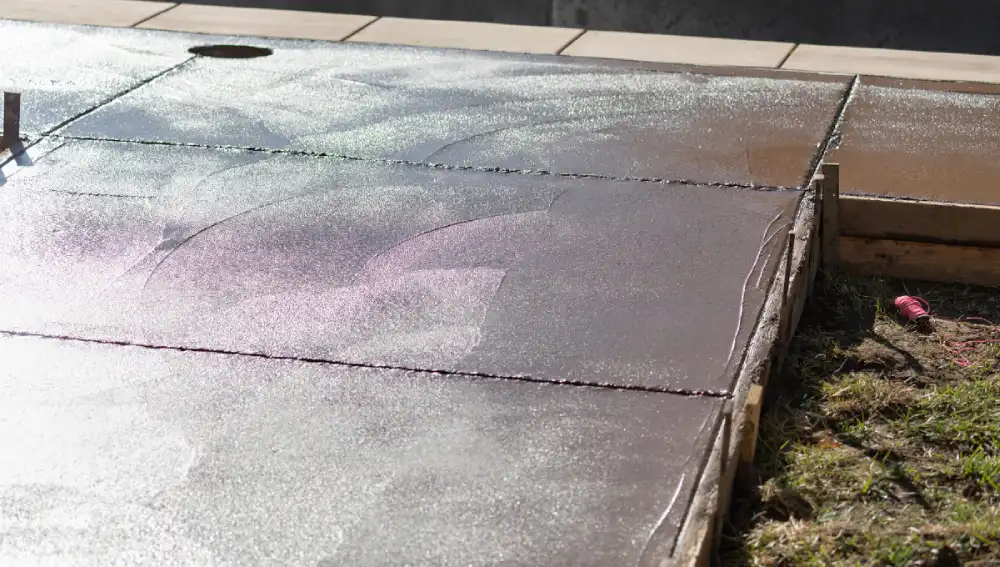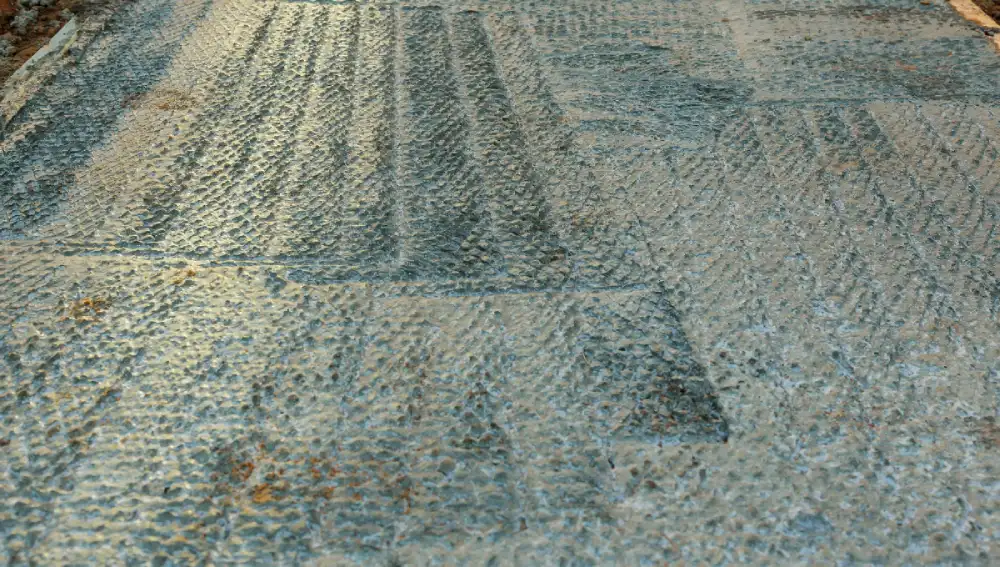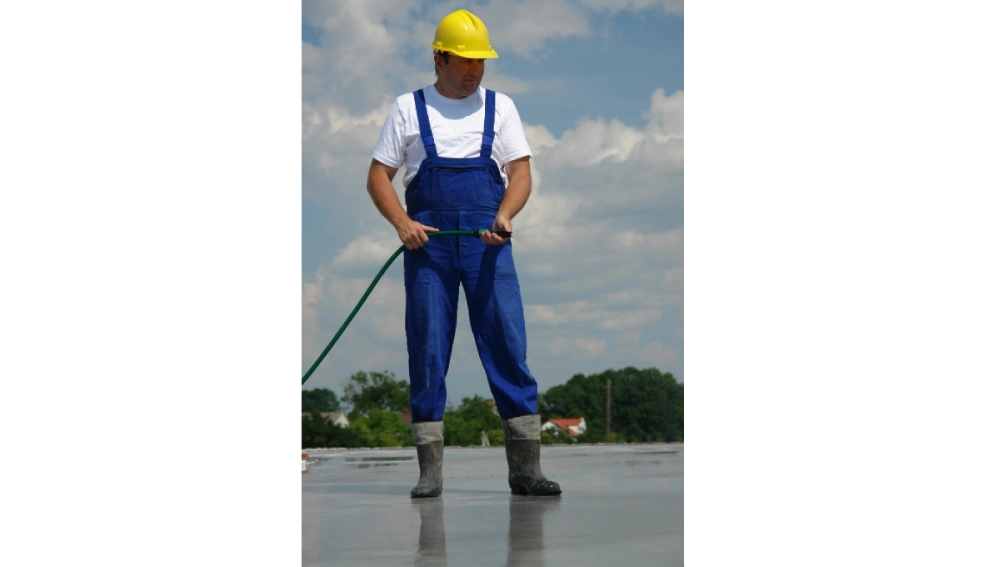Curing is a crucial process in construction, particularly when it comes to concrete structures. It involves maintaining adequate moisture, temperature, and time to allow the concrete to achieve its desired strength and durability. Let’s dive into what curing is, why it’s important, and how it’s done, along with some real-life applications.
What is Curing?

Curing is essentially the process of keeping the concrete moist and warm enough so that the chemical reactions involved in the hydration of cement can continue. This hydration process is vital because it leads to the hardening and strengthening of concrete.
Methods of Curing
Water Curing
Water curing means keeping the concrete surface wet all the time. This helps the concrete get strong by preventing it from drying out too quickly.
How It’s Done:
Ponding: This is like creating small ponds on flat surfaces. You build small temporary walls around the area and fill it with water, keeping the concrete submerged.
Spraying: If ponding isn’t possible, you can spray water on the concrete regularly. This is usually done with hoses or sprinklers.
Wet Coverings: Another way is to cover the concrete with wet materials like burlap (a type of cloth) or cotton mats. These covers are kept wet by spraying water on them.
Membrane Curing
Membrane curing involves applying a special coating on the concrete surface that seals in moisture, preventing the water from evaporating.
How It’s Done:
Curing Compounds: These are liquid solutions (like wax or resin) sprayed or painted on the concrete. They form a thin film that locks in moisture.
Plastic Sheets: Sometimes, plastic sheets are laid over the concrete. These sheets act as a barrier, trapping moisture inside.
Steam Curing
Steam curing uses steam to speed up the curing process. This method is especially useful in colder weather or when you need the concrete to set quickly.
How It’s Done:
Enclosed Spaces: Precast concrete elements (like beams or columns) are placed in an enclosed space where steam can be pumped in.
Temperature Control: The steam increases the temperature and humidity around the concrete, accelerating the curing process.
Curing by Absorption
This method involves covering the concrete with absorbent materials that are kept wet. These materials hold water and slowly release it to the concrete.
How It’s Done:
Materials Used: Common materials include sand, sawdust, or hay. These materials are spread over the concrete surface.
Maintaining Moisture: The covering materials are kept wet by regularly adding water to them, ensuring that the concrete stays moist.
Applications of Curing

Building Foundations
The Building foundation is the most critical part of any building, providing stability and support to the entire structure. Proper curing of the foundation is essential to ensure it develops the necessary strength and durability.
Method Used: When it comes to building foundations, water curing is the most common method used. This involves keeping the foundation moist continuously.
Process of Water curing:
Initial Wetting: After the concrete is placed and finished, the curing process begins with an initial wetting phase. The surface is sprayed with water to prevent it from drying out.
Covering: The foundation is then covered with wet burlap, cotton mats, or polyethylene sheets to retain moisture.
Regular Wetting: The covers are kept wet for at least 7 days. This is done by sprinkling water regularly to ensure consistent moisture.
Road Construction
Roads need to be durable and able to withstand heavy traffic loads. Proper curing ensures that the concrete pavement develops the necessary strength and resists cracking.
Method Used: Membrane curing is frequently used for road construction due to its practicality for large surfaces.
Process of Membrane Curing:
Application of Curing Compound: Once the concrete is set, a curing compound (often a liquid membrane-forming compound) is sprayed onto the surface.
Sealing the Surface: The compound forms a thin film over the concrete, which prevents water from evaporating too quickly.
Maintenance: The compound remains on the surface until the curing period is complete, typically 7-14 days. It may need to be reapplied if damaged by traffic or weather conditions.
Bridge Construction
Bridges, especially those exposed to varying weather conditions, require curing methods that can maintain uniform temperature and moisture levels. Proper concrete curing types is crucial to ensure the concrete achieves the strength needed to support heavy loads and resist environmental stress.
Method Used: Steam curing is often used for bridge construction, particularly in cold climates or where accelerated curing is needed.
Process of Steam curing
Enclosure: The precast concrete elements (such as beams and supports) are enclosed in a steam chamber or tented area.
Steam Application: Steam is introduced into the enclosure, raising the temperature and humidity around the concrete.
Temperature Control: The temperature is carefully monitored and maintained to ensure it remains within the optimal range for curing.
Precast Concrete Elements
Precast concrete elements, such as beams, slabs, and columns, need to be cured quickly and efficiently so they can be transported and installed at the construction site without delay.
Method Used: Steam curing is commonly used in precast concrete plants to expedite the curing process.
Process of Steam curing:
Controlled Environment: The precast elements are placed in a controlled environment where steam can be introduced.
Application of Steam: Steam is applied to maintain a high humidity level and elevate the temperature.
Accelerated Curing: The high temperature and humidity accelerate the curing process, allowing the concrete to achieve the desired strength much faster than traditional curing methods.
Importance of Curing
Strength Development: Proper curing ensures that concrete achieves its designed strength. Without adequate curing, the concrete might not reach its potential strength, leading to weaker structures.
Durability: Curing improves the durability of concrete by reducing its permeability. This means that the concrete is less likely to be affected by weathering, freezing and thawing cycles, and chemical attacks.
Surface Quality: Adequate curing prevents surface defects like cracks, dusting, and scaling, ensuring a smooth and even surface finish.
Minimizes Shrinkage: Curing helps in minimizing shrinkage and cracking. Uncured concrete can lose water rapidly, leading to cracks and structural issues.
Conclusion
Curing is a fundamental aspect of concrete construction, vital for achieving the desired strength, durability, and quality of the final structure. By understanding the different methods and their applications in real-life scenarios, construction professionals can ensure their projects stand the test of time. Whether it’s building foundations, roads, bridges, or precast elements, proper curing practices are essential for the long-term success and safety of any construction project.
FAQS
The curing time for Reinforced Cement Concrete (RCC) typically spans 7 to 14 days. Proper curing is essential to achieve optimal strength and durability. During this period, the concrete should be kept moist to prevent cracking and ensure proper hydration of the cement.
Curing is commonly recommended for 28 days because this period allows concrete to reach its full strength and durability. Although concrete begins to set and harden quickly, it continues to gain strength over time. The 28-day curing period is based on the standard time required for concrete to achieve its design strength, typically around 70-80% of its potential strength.

